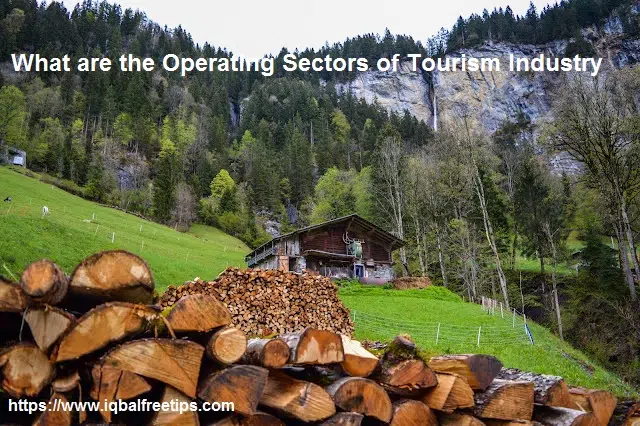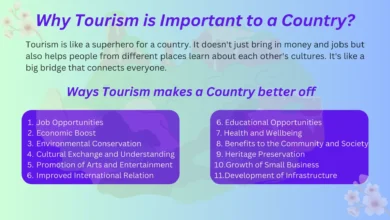
What are the Operating Sectors of Tourism Industry?
The tourism industry generates billions of dollars in revenue each year and employs tens of millions of people around the world. Tourism, whether it’s foreign or domestic, comes from many different sources, but the majority of tourists come from a handful of specific industries that provide much-needed help to economies everywhere.
Knowing the different operating sectors of the tourism industry will help you better understand how to attract tourists to your region or country and benefit from their positive economic impact. Here are some tips on the different types of operating sectors in tourism.
Introduction:
The tourism industry is a major contributor to economies across nearly every continent. However, it’s more than just an industry; it’s an art form and a passion. Tourism supported one in ten jobs around the world, as well as two billion jobs indirectly. This support is valued at $7 trillion USD per year – three times larger than any other service industry.
With such huge contributions to GDP, employment, and trade balance, you might think that everyone knows what makes up the tourism industry. But there are actually many different segments within tourism: leisure travel, business travel, international students studying abroad on J-1 visas, or working abroad on F-1 visas for example. Understanding these segments can help you identify which ones are most profitable for your own business. Here’s a breakdown of how each segment works, its biggest challenges, and some tips for success.
Hotels and lodging:
Hoteliers are in charge of hotels, motels, inns, and other lodging facilities. In most cases, they also oversee or own restaurants and bars on-site. Some provide tourism information to guests; others offer travel packages that include airfare and hotel stays.
Hoteliers work long hours and spend a lot of time on their feet, but they usually have a lot of autonomy in determining operating procedures within their business model. Their earnings depend largely on how many rooms they can fill. According to CareerBuilder, an average front-desk manager earns $31,200 per year.
 |
| Hotels and Lodging |
Transportation:
Airlines, railways, ferries, and cruise ships are responsible for transporting people and goods to and from destinations. The tourism industry depends on transportation companies to move tourists around once they arrive at their destinations. If you’re looking to work in travel and hospitality, transportation is a good place to start your career.
Airline attendants, train conductors, and ferry workers all fall under transportation jobs in tourism. These workers are essential in ensuring that tourists have safe, comfortable journeys between destinations. They also ensure that passengers adhere to any special rules or regulations set by airlines or other transportation providers.
Airline staff, for example, must ensure passengers meet certain age requirements before allowing them onto flights. They also must check each passenger’s identification to make sure he or she has valid tickets and proper documentation before allowing them onto planes. In addition to providing basic safety guidelines, many airline staff members must also be trained in first aid techniques as part of their job responsibilities.
 |
| Transportation |
Foodservice:
Restaurants and bars are a major part of food service, and most operate year-round. In fact, it’s one of the few sectors that have openings for seasonal employees. While there’s a lot to learn from how to run front-of-house duties to how a kitchen works the perks are excellent. You work in fun environments with great people, serving delicious food and drinks. You can get real experience in managing staff and finances while still earning good money.
 |
| Food Service |
Recreation and entertainment:
Recreation is one of the largest operating sectors in tourism, accounting for 14 percent of all tourism expenditures. Entertainment venues include theme parks, sports arenas, and convention centers. These venues attract customers with musical events, plays, and family-friendly attractions. The largest entertainment attraction is Disney World near Orlando, Florida.
It hosted more than 20 million visitors, making it one of the most visited tourist destinations on Earth. Other popular recreation destinations include casinos, state fairs, and water parks. Many recreation facilities operate year-round to accommodate seasonal tourism spikes. For example, ski resorts remain open during summer months to accommodate skiers and snowboarders who are looking for fun before school starts up again.
Community, social, and personal services:
If you have a special talent, such as painting or playing music, you can make money by selling your wares to other tourists. Also, check with tour companies to see if they need guides for their tours most will pay $25-75 per day. But keep in mind that it is often difficult to make enough money at odd jobs to support yourself for very long. It’s much more realistic to generate income through paid employment while traveling.
See below for more ideas on making money while traveling. The tourism industry includes businesses and industries directly involved in moving people from one place to another for recreation and leisure activities, but also for business and work-related travel. Tourist businesses generally fall into two categories: transport providers (airlines, bus lines, cruise ships) and accommodation providers (hotels, resorts). Transport services are provided by non-residential establishments like airports, hotels, etc., whereas accommodation services are provided by residential establishments like restaurants and guest houses.
Professional, scientific, and technical services:
These businesses provide a range of services from engineering to marketing to legal assistance. In tourism, these services are used to support infrastructure projects and operations, as well as in management, travel planning, and retail activities.
Professional scientific and technical services include architectural, design, and related services; computer systems design and related services; legal services; accounting, bookkeeping, and payroll services; advertising agencies; public relations firms; architectural design firms; market research organizations; testing laboratories.
Administrative and support services:
This includes all those jobs that are needed to run your company, but that isn’t necessarily related to what you do. For example, if you own a restaurant, there’s likely to be a need for administrative staff like receptionists, accountants, and HR personnel.
Or if you operate a travel agency, there will almost certainly be an admin support team managing accounts and ordering supplies. Administrative and support services typically make up somewhere between 30% and 40% of total tourism employment across countries.
Public administration and defense; compulsory social security:
The government sector plays a major role in tourism. It supports and promotes tourism through public funding and private-public partnerships. The goal is to increase tourism revenue and jobs, which will lead to economic growth.
The federal government funds programs such as Brand USA, an organization that markets U.S. travel and tourism to foreign visitors. This program relies on money from taxes collected from international travelers’ spending on hotels, meals, gas, and more while visiting America the most popular travel destination in the world!
Education:
In addition to experiencing different cultures and immersing themselves in a new environment, many people travel with a specific educational objective in mind. A study trip allows people to get first-hand experience outside their home country, a valuable resource that can make them better teachers and role models for students back home. While education is often associated with higher learning, there are also opportunities for professional development through travel.
 |
| Study Trip |
Human health and social work activities:
Direct and indirect activities; Management, scientific and technical consulting services; Scientific research and development; Architectural, engineering, and other technical services, including surveying and mapping; Specialized design services; Security, investigation, and intelligence activities; Activities of employment placement agencies; Activities of employment agencies specializing in travel reservations.
Arts, entertainment, recreation, accommodation; other service activities; customer service activities; grantmaking, philanthropic, and non-profit management activities:
These are operating sectors of the tourism industry. The sector consists of many different sub-sectors, such as arts, entertainment, and recreation; accommodation; other service activities; customer service activities; non-profit institutions serving households; grantmaking, philanthropic, and non-profit management activities. It also includes support activities for all other industries.
Conclusion:
The tourism industry is now a multi-billion dollar business that employs millions of people in jobs ranging from direct employment to indirect business support. Many people wonder what kind of job they can get in tourism, and there are a number of different opportunities depending on your skill set. You might want to start with some sort of physical labor or support role, or you might want to become an educator that gives tourists valuable tips while they’re visiting.




